Rapporti ISTISAN 09/49 ISTITUTO SUPERIORE DI SANITÀ Ageing ...
Rapporti ISTISAN 09/49 ISTITUTO SUPERIORE DI SANITÀ Ageing ...
Rapporti ISTISAN 09/49 ISTITUTO SUPERIORE DI SANITÀ Ageing ...
Create successful ePaper yourself
Turn your PDF publications into a flip-book with our unique Google optimized e-Paper software.
<strong>Rapporti</strong> <strong>ISTISAN</strong> <strong>09</strong>/<strong>49</strong><br />
element common to all the different meanings of this term can be found by the prior assumption<br />
of a possible negative evolution result. In the research of non adaptive outcomes of development<br />
processes the idea of bio-psychological-social risk has been used with reference to all those<br />
situations which regardless of the factors involved, cause compromises in the trend of evolution<br />
lines or an unsuccessful integration between the individual and the environment. In the<br />
investigations (widespread since 1970) on risks in terms of development, it is possible to<br />
distinguish three directions. A first direction tries to identify a direct causal link between a<br />
single risk factor and a result derived from bad adaptation. It implies a deterministic conception<br />
of development and can be referred to the medical model of etiopathogenesis of morbid states.<br />
A second direction is focused on risk measurement and on the identification of psycho-social<br />
risk cumulative indexes, thanks to which it is considered to be possible to define the degree of<br />
danger or risk of a certain situation. Such point of view, even if it admits the idea of a<br />
multifactorial causality in determining negative development outcomes, it does not seem to<br />
suitably consider the process dimension which is implied in an evolution line, in which the<br />
interaction between the existing risks and the available resources becomes important. The third<br />
direction is centred on the analysis of adaptation processes. It takes into account the incidence of<br />
risk factors and protection factors considered as specific resources of single life stories. It tries<br />
to explain the way an individual and his context reciprocally interact in producing forms of<br />
adaptive or disadaptive functioning. From this point of view it is then necessary to consider both<br />
the characteristics of life events and the personal characteristics, because only by evaluating<br />
such characteristics within specific contexts and within a systemic and relational perspective the<br />
function of damage or protection, which they perform on the individual’s life, can be explained.<br />
The idea is that of putting the conception of risk together with that of resilience, intended as<br />
the ability of the individual of being flexible, of carrying out a good adaptation, notwithstanding<br />
difficulties. To resort to the idea of resilience allows explaining individual differences in<br />
responses to negative life events. A well known literature today shows as only a part of the<br />
elderly exposed to risk factors, produces dysfunctional or pathological responses. In this sense,<br />
the problems of risk prediction are strictly linked to that of protection, even if up to date, we<br />
must recognise that the study of protection risks has been quite neglected. It certainly deserves a<br />
greater interest, since it is absolutely necessary to understand what factors, what abilities can be<br />
consolidated, in order to let the elderly be more resistant. The researches made up to now let us<br />
sustain that resilience is not a stable feature of personality (Sroufe & Rutter, 1984) because it<br />
can be found in the different development processes. Protection factors have a less influence<br />
according to a variety of elements among which there are the evolution stage under<br />
consideration, the individual’s sex and the kind of disturbance which they are expected to<br />
contrast. However, even if they are not so many, the studies carried out in this field (Sameroff &<br />
Seifer, 1990) have underlined that protection factors which define resistance, even if they are<br />
classified in different ways, fall within the range of cognitive or social-relational processes.<br />
Even if they are for many aspects different from risk factors, what they have in common with<br />
them, is that they carry out their action within processes which take place in the interaction<br />
between the individual and the environment. The relationship between the individual and the<br />
environment can better be defined in terms of life space, a lewinian conception later taken by<br />
Bronfenbrenner (Bronfenbrenner, 1979), who refers to the whole of personal and environmental<br />
forces involved, influencing the individual’s behaviour. The Bronfenbrenner’s model (defined<br />
person-process-context) is considered the most advanced point reached by researches on risk,<br />
because it efficiently integrates personal characteristics with categories of an environmental<br />
kind, then putting apart the mere overlapping of the psychic with the social dimension. They<br />
cannot be analysed separately, because from their interdependence, positive or negative<br />
evolution outcomes are caused. The ecological approach to human development by<br />
24



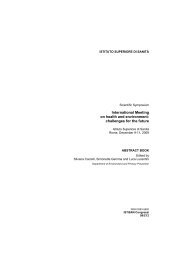
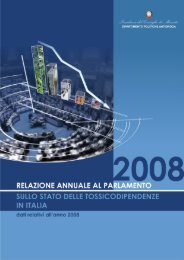
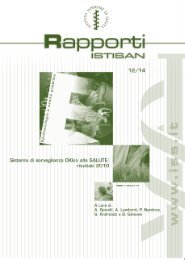
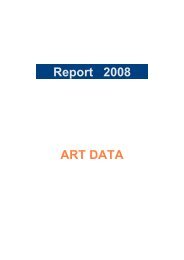
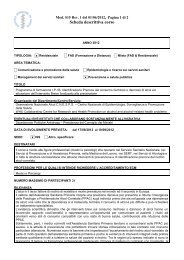
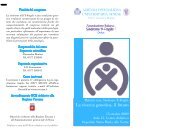
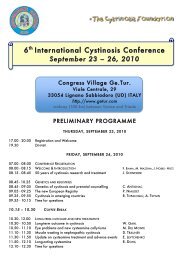
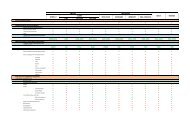
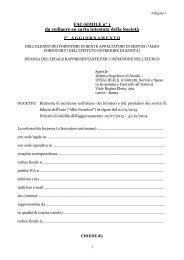
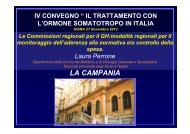
![Emilia Romagna [PDF - 175.10 kbytes]](https://img.yumpu.com/23556597/1/184x260/emilia-romagna-pdf-17510-kbytes.jpg?quality=85)
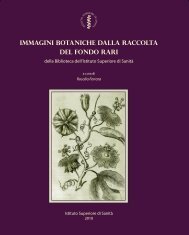
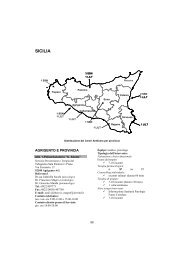
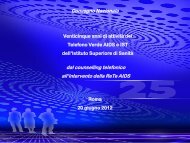
![Istisan Congressi N. 66 (Pag. 1 - 81). [PDF - 2021.12 kbytes] - Istituto ...](https://img.yumpu.com/23556493/1/171x260/istisan-congressi-n-66-pag-1-81-pdf-202112-kbytes-istituto-.jpg?quality=85)